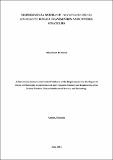| dc.description.abstract | Human African Trypanosomiasis (HAT), also known as sleeping sickness is a neglected dis ease that impacts 70 million people living in 1.55 million km2
in sub-Saharan Africa. The
disease strikes predominantly poor populations in sub-Saharan Africa and has been targeted
for elimination as a public health problem by 2030. Despite decades of control operations, the
disease remains enigmatic and persists in populations at low levels of prevalence. Hence sev eral research approaches must be utilized to infer on the feasibility of attaining the set target.
Among them, mathematical modeling is a very successful tool and has been extensively used
for different diseases.
In this study four mathematical models were proposed to evaluate the effects of educational
campaigns, seasonality, memory effects, time delay and heterogeneity in the human population
on Trypanosoma brucei rhodesiense transmission and control dynamics. In the formulated
models the basic reproduction number R0 was computed and qualitatively used to establish the
condition for disease eradication and persistence. In the first model, effects of human awareness
through educational campaigns and use of insecticides on short-and long-term dynamics of the
disease were evaluated. Analytical results of the study showed that the model undergoes a
backward bifurcation.
Further, upon extending the model to incorporate time-dependent educational campaigns and
the use of insecticides, it was noted that when the aforementioned strategies were intensified
the associated costs were also high, and the reverse was true. Moreover, it was also noted that
reducing the upper bound of educational campaign control (u1) from 1 to 0.5 and insecticide
control (u2) from 1 to 0.3 could lead to a 17.6% reduction in costs.
Next, the model system was extended to include temperature and case detection followed by
treatment of infected humans. With the aid of suitable Lyapunov functionals, the global stability
of the model’s steady states was carried out. Upon simulating the model with temperature
fixed at 20 and 25◦C, it was noted that the value of vector control be greater than 30 and 50%
respectively for R0 to be less than unity. Lastly, the time delay factor was included in the model
system to assess the effects of incubation period on the dynamics of T. brucei rhodesiense
disease in the population. The numerical results demonstrated that the inclusion of the time
delay factor in the model system destabilized the endemic equilibrium point leading to Hopf
bifurcation. | en_US |

